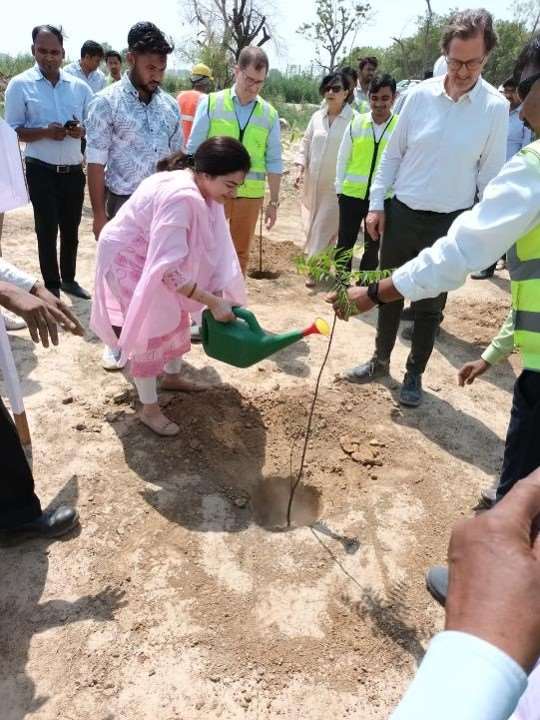Biodiversity
Biodiversity refers to the variety of species and habitats. The Zurich Airport Group is helping to conserve and promote such diversity at its various sites.
Relevance
The Zurich Airport Group protects the ecological value of the green spaces at its airports and helps to conserve and promote biodiversity.
As Zurich Airport was originally built in the middle of reed meadows, its perimeter still encompasses extensive areas that are of especially high ecological value. Of the total 953 hectares within its perimeter, around half is green space. Thanks to the airport fence, a mosaic of different habitats provides animals and plants – in some cases rare ones – with a home where they can be largely undisturbed. A total of 74 hectares are designated nature conservation areas, including wetlands of national importance. The company aims to preserve these habitats within the airport perimeter, especially since they are of a nature and quality that has become something of a rarity elsewhere in the central plateau.
The Zurich Airport Group also promotes biodiversity at its airports abroad. The Florianópolis, Vitória and Macaé airports in Brazil are near the coast and therefore adjacent to sensitive ecosystems. Biodiversity is also acknowledged as an important issue in connection with the construction of the new airport in India. At its two sites in Chile, the airfields along with their development and maintenance are in the hands of the authorities.
Approach
As well as safety and operational considerations, international regulations also include specific requirements or recommendations with regard to the maintenance and conservation of green spaces around airports. Together with nature conservation stipulations in local legislation, these form the framework for how Zurich Airport Ltd. manages green areas not used for aviation purposes.
At its Zurich site the company is doing everything necessary to preserve the ecological value of the protected areas within the airport perimeter and to meet the associated conservation goals defined by the authorities. The protected areas include wetlands with various habitats and wooded areas. Cultivation of extensive tracts of the airport grounds as high-grass meadows is in fact in the interests of both airfield operations and nature conservation.
When Zurich Airport Ltd. plans to build on green areas, their ecological value is measured using recognised methods. As part of the subsequent construction project, the company then offsets this by compensatory measures of equal value elsewhere. It aims to create areas with high-quality habitats appropriate to the location wherever possible, for example ones considered a priority by the Confederation.
Whereas in the past efforts have been directed to the specific careful management of large parts of the green spaces to preserve and even increase biodiversity to some extent, the focus in the year under review shifted to its active encouragement. Modified measures set out in a revised concept aim to further increase species and habitat diversity over the next few years. These include action to be taken in woods, in existing nature conservation areas on the airfield, and for designated compensatory areas in the region.
Work has already begun on implementing measures in the wood: for instance, specific steps have been taken to support one species of butterfly in a wood to the south. In addition, a start was made on counting bat numbers so that targeted action can later be taken to increase species diversity. All these planned actions will positively influence biodiversity in general as individual measures always have an influence on the overall ecosystem.
Preserving biodiversity is important in Brazil too. In Vitória, for example, land which was already built on before the company acquired the operating licence in the lead up to construction of the new terminal will be “offset” by upgrades both on the airport site and elsewhere. This will be done at the section of beach at Curva da Jurema where ecological improvements are restoring the original coastal vegetation.
In Noida, India, where construction of the new airport impacts both agricultural land and human settlements, over 1,800 trees have been planted. This extensive reforestation also serves to compensate for the trees that were felled. The company is obliged to ensure that planting and reforestation are successful and to rectify any problems that arise. Comprehensive monitoring covering soil, drinking water, wastewater, air quality and noise feeds into monthly reports documenting the associated impacts so countermeasures can be taken quickly if necessary. The companies contracted to carry out the building work are in turn obliged to take the steps necessary to prevent harm to the natural environment.
Bird strikes
With its wooded areas, watercourses and large open spaces, Zurich Airport also attracts a large number of bird species. However, large birds and flocking birds in particular can present a safety risk for aircraft. Collisions between birds and aircraft (known as bird strikes) can have very serious consequences and so must be avoided at all costs.
Various steps are taken at the Zurich site to make the airfield less attractive to birds that pose a particular risk to safety in an effort to avoid potential collisions. One tactic is to cultivate most of the open areas as extensive high-grass meadows; this approach is also taken at the companyʼs airports in Brazil. This is both environmentally friendly and also helps to prevent bird strikes as the high grass makes it difficult for birds of prey to spot their prey on the ground. It also discourages flocking birds from settling there. Specific steps have also been taken to reduce the birdsʼ food supply – for instance weasels especially are encouraged because they compete with birds of prey in hunting small mammals.


